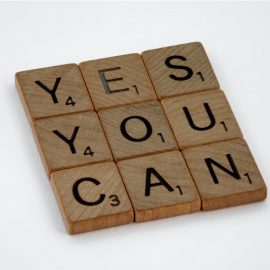

This article is an excerpt from the Shortform book guide to "The Dictionary of Body Language" by Joe Navarro. Shortform has the world's best summaries and analyses of books you should be reading.
Like this article? Sign up for a free trial here.
Can you tell when someone is anxious? Is sweating always a sign of stress?
If you were able to detect when someone else is stressed out, imagine how helpful it would be to be able to adjust your own words and behavior accordingly. In The Dictionary of Body Language, retired FBI Special Agent Joe Navarro shares four common anxious body language cues.
Keep reading to learn how to tell if someone is anxious by interpreting their body language.
Anxious Body Language: Repeated Actions
Navarro shares several tips on how to tell if someone is anxious, first pointing to the fact that many body language cues that signal stress involve repeated actions. Repetition has a calming, settling effect on the nervous system. Therefore, if someone repeats the same behavior over and over in a short period of time, they’re likely attempting to soothe themselves.
Navarro names the following as common anxious body language cues that entail calming, repeated actions.
Action #1: Massaging the Chest From the Shoulder and Across the Collarbone
Navarro describes how, when engaging in this calming, tactile action, people place a hand on the shoulder opposite (right hand to left shoulder or left hand to right shoulder). They then move their hand along the collarbone from their shoulder to their chest.
(Shortform note: The pressure of massage—whether self-initiated or conducted by someone else—sends signals to the brain that help you relax and reduce pain. When you exert pressure on your skin’s nerve cells, your body releases endorphins and reduces levels of the stress hormones adrenaline and cortisol. Endorphins naturally make you feel euphoric and prevent signals from the brain that trigger pain.)
Action #2: Swaying the Torso Forward and Backward Starting at the Hips
Repeatedly swaying the upper body forward and backward while sitting down is frequently an indicator of intense psychological distress. Navarro asserts that you might observe this action in people attempting to calm themselves while experiencing a traumatic event.
However, he states that this is also a common action undertaken by neurodivergent people (who aren’t necessarily in distress), such as people on the autism spectrum. So, context is important when assessing this cue.
| Stimming: Repetitive Actions to Comfort and Engage the Brain Habitual actions involving repetitive movements or sounds are considered self-stimulatory behaviors—also known as stimming. As Navarro states, stimming is often a trait of people who are on the autism spectrum or otherwise neurodivergent, but not always. According to some experts, we often stim without thinking about it, but it usually has a purpose. As we noted earlier, this could be to calm ourselves. It may also be to reduce overstimulation or show excitement. Sometimes people also stim simply because it’s enjoyable—in one study, 80% of adult participants said they stim because it feels good. Examples of common stimming behaviors include finger tapping, rocking (as Navarro mentions here), blinking, and humming. As well as being a calming motion as Navarro suggests, research suggests that rocking may have a sedative effect. Results from one study found that rocking reduced the time it took for participants to fall asleep and increased the amount of time they spent in a deep sleep. Additionally, participants displayed better memory recall after sleeping while being rocked. Another study conducted with mice demonstrated that this effect may relate to rocking’s effect on mammals’ inner ear organs. Rocking stimulates the vestibular system, which includes the sensory organs inside our ears that help us balance and orient ourselves spatially. Half of the mice in the study had normal vestibular systems and the other half had decreased function. The half with the normal vestibular function experienced the sedative effects of rocking, but the half with altered vestibular systems didn’t. |
Anxious Body Language: Cooling Actions
Navarro argues that many cues that indicate anxiousness and stress (and our desire to soothe these feelings) have a cooling effect. When we’re feeling stressed, our bodies get uncomfortably warm. Therefore, we seek to return our bodies to a cooler, more comfortable temperature.
(Shortform note: One option for manually cooling your body is icing, and thus activating, your vagus nerve—the large nerve responsible for regulating digestion, breathing, and heart rate. You can do this by placing ice or a cold compress on the back of your neck or on your chest. Doing so has the side effect of soothing anxiety. When the vagus nerve activates, it slows your heart rate, lowers your blood pressure, and tells your body that it’s okay to calm down.)
Before assessing the driving factor behind these behaviors, however, Navarro suggests considering the context of the situation. Specifically, he notes that a high ambient temperature may prompt these behaviors by making people feel warm. In this case, internal stress may or may not be involved, so use other cues to judge the person’s emotions.
| Why Anxiety Makes Us Feel Hot and Heat Makes Us Anxious Experts suggest that we feel hot when we’re stressed and anxious because of the fight or flight response—our body’s way of getting us ready to face danger. When we go into fight or flight mode, our body sends out stress hormones such as adrenaline and cortisol. These hormones increase blood flow to the muscles, making us feel warm. It may also be a combination of stress and high temperatures that drives someone to engage in calming, cooling behaviors. High heat itself can lead to increases in cortisol levels, nausea, fatigue, and heart palpitations. These symptoms resemble those of a panic attack, which may result in feelings of anxiety and fear. |
The following anxious body language cues calm by cooling, suggesting that the person displaying them may be overheated because of anxiety or stress.
Action #1: Increasing Airflow to the Body
According to Navarro, people will commonly try to cool their bodies when stressed by increasing airflow to their skin. For example, you might see a stressed, overheated person adjusting their hair to increase airflow to the head and neck: Men usually cool the top of their heads by threading their fingers through their hair, while women typically hold up their hair from the back of their neck.
(Shortform note: This gender-based pattern of cooling behaviors may be linked to modern hair fashions in many cultures. Long hair is often viewed as feminine (meaning women have more hair covering the neck), while short hair is frequently viewed as more masculine (meaning it’s easy for men to run their fingers through it). However, hair length is increasingly becoming less gendered as more people express themselves outside of the traditional gender binary. Therefore, gender may no longer be the best way to define these behaviors.)
Action #2: Sweating Profusely
Navarro states that you may observe people sweating profusely when they’re stressed. He notes that this is especially common when someone’s nervous or trying to deceive you. Sweating is their body’s way of cooling them down—the added moisture creates a cooling effect as it evaporates from the skin.
(Shortform note: Sweating is such a common sign of stress and nervousness that it’s become an idiom in American English. When we want someone to stop worrying about something, we tell them, “Don’t sweat it.” Similarly, when we plan to pressure someone (for instance, if we plan to get them to tell the truth), we might say, “I’m going to make them sweat.”)

———End of Preview———
Like what you just read? Read the rest of the world's best book summary and analysis of Joe Navarro's "The Dictionary of Body Language" at Shortform.
Here's what you'll find in our full The Dictionary of Body Language summary:
- A former FBI Special Agent's guide to body language
- Why you should assess body language cues collectively, not individually
- The body language cues that indicate stress, boredom, anger, doubt, and more






